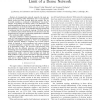Free Online Productivity Tools
i2Speak
i2Symbol
i2OCR
iTex2Img
iWeb2Print
iWeb2Shot
i2Type
iPdf2Split
iPdf2Merge
i2Bopomofo
i2Arabic
i2Style
i2Image
i2PDF
iLatex2Rtf
Sci2ools
INFOCOM
2009
IEEE
2009
IEEE
Noncooperative Load Balancing in the Continuum Limit of a Dense Network
Abstract—In transportation network research, the main approach for predicting traffic distribution due to noncooperative vehicle choices has been through fluid type models. The basic model considers a continuum of infinitesimal “non-atomic” vehicles, each seeking the shortest path to its destination. The resulting equilibrium turns out to be much simpler to characterize in comparison to the finite-vehicle case, yet provides a good approximation to the latter. A less familiar fluid-type model uses a continuum limit for the network topology. The limit network is a continuum plane which inherits its cost structure from the original network, and the corresponding equilibrium is identified as the continuum traffic equilibrium. This paper considers a similar equilibrium notion in a framework of a load balancing problem involving two processors, each requiring non-negligible workload (or “flow”) to be handled by network resources. Besides a congestion cost at each resource (...
Communications | Continuum Limit | Continuum Traffic Equilibrium | INFOCOM 2009 | Similar Equilibrium Notion |
| Added | 24 May 2010 |
| Updated | 24 May 2010 |
| Type | Conference |
| Year | 2009 |
| Where | INFOCOM |
| Authors | Eitan Altman, Ishai Menache, Asuman E. Ozdaglar |
Comments (0)

